Selecting the Right Conveyor Return Idler
In the intricate world of conveyor belt systems, the role of conveyor return idler stands as a cornerstone for efficient operations. These often-overlooked components play a vital role in preserving the durability and longevity of a conveyor belt. Conveyor return idlers, strategically placed beneath the conveyor belt, are crucial for supporting its return path. Their main purpose is to provide a smooth surface for the belt to move across, reducing friction and wear. This is essential for extending the belt’s lifespan and ensuring uninterrupted operation. The significance of conveyor return idlers cannot be emphasized enough, as they are essential for minimizing belt sag, preventing slippage, and maintaining optimal tension. All of these factors are critical for the smooth and efficient operation of conveyor belt systems.Their role in maintaining belt alignment and preventing material build-up further underscores their significance in the seamless operation of conveyor systems.
What is conveyor return idler
conveyor return idler are integral components in the mechanics of conveyor belt systems. Conveyor return idlers are specialized rollers positioned beneath the conveyor belt, serving the purpose of supporting the returning section of the belt. Their primary function is to ensure a consistent and stable surface for the non-carrying side of the belt as it moves back to the beginning of the conveyor system. This role plays a critical part in preventing belt sag, which can result in material spillage and heightened wear and tear.
The importance of conveyor return idler extends beyond just supporting the belt. These components have a crucial function in ensuring the conveyor belt remains properly aligned and tensioned. Maintaining the correct alignment and tension of the belt is essential for efficient operation and preventing it from deviating from its intended path. A conveyor return idler achieves this by being strategically placed and often adjustable to ensure that the belt remains centered and taut. This alignment is critical to prevent uneven wear on the belt and to ensure smooth, uninterrupted operation of the conveyor system.
Conveyor return idlers are not just passive components; they actively contribute to the longevity and efficiency of conveyor belt systems by supporting the belt, maintaining its alignment, and ensuring optimal tension. Their role is fundamental in minimizing operational disruptions and prolonging the lifespan of the conveyor belt.
Types of Conveyor Return Idler
The world of conveyor return idler is diverse, with each type designed to meet specific operational needs. Understanding these variations is key to optimizing conveyor belt performance.
Function and Importance
- Support for the Return Belt: These idlers provide a smooth surface for the conveyor belt to ride upon on its return trip, ensuring it maintains the proper path without sagging or slipping.
- Prevents Belt Wear: By supporting the belt, return idlers minimize the wear and tear on the conveyor belt, extending its lifespan.
- Maintains Tension: Properly spaced return idlers help maintain the right tension in the conveyor belt, which is crucial for efficient operation and preventing slip or excessive wear.
Types of Conveyor Return Idlers
Self-Aligning Return Idler: These specialized conveyor return idlers are engineered to assist in maintaining proper belt alignment, which is crucial for efficient operation. The self-aligning return idler automatically adjusts the belt to the center of the conveyor, reducing the risk of belt damage due to misalignment. This feature is particularly beneficial in environments where the conveyor path may experience shifts or disturbances. The self-adjusting mechanism ensures minimal manual intervention, leading to reduced downtime and maintenance costs.
Standard Return Idlers: Standard return idlers are the most commonly used type in conveyor systems. These components are known for their uncomplicated yet sturdy design, offering dependable support for the return side of the conveyor belt. Typically, these idlers are constructed with a steel tube and bearings at both ends, which makes them suitable for various applications. Their versatility and durability make them a popular choice for many conveyor systems, striking a balance between performance and cost-effectiveness.
Superior Idlers: Reliable foundatings Idlers are to conveyors as foundations are to buildings: constant, reliable support.For proper operation, idlers need a sophisticated seal to protect their bearings in all conditions. Second, conveyor owners need a variety of models and options to handle and endure application-specific environments. Third, idler consumers require a modern manufacturer who is built to respond quickly.Superior idlers are designed for enhanced performance and longevity. These idlers often feature advanced designs, such as improved sealing systems to protect bearings from contaminants, and high-quality materials for increased wear resistance. The unique features of superior idlers can include impact-absorbing capabilities, noise reduction, and reduced rolling resistance, which contribute to longer belt life and reduced energy consumption. They are ideal for demanding applications where standard idlers may not suffice.
PPI Return Idler: PPI (Precision Pulley & Idler) return idlers are known for their precision engineering and quality. These idlers are designed to meet specific application requirements and are available in various sizes and configurations. PPI return idlers often feature enhanced sealing technology and are built to withstand harsh operating conditions, ensuring reliable performance and reduced maintenance needs. Their specifications are tailored to provide optimal support and protection for the conveyor belt, making them a preferred choice in many industrial settings.
Flat Return Idlers: These are the most common type, featuring a single horizontal idler roll that supports the return side of the belt. They are simple in design and effective for most applications.
V-Return Idlers: V-return idlers incorporate two or more rolls set at angles to form a ‘V’ shape. This design offers enhanced support and guidance for the belt, particularly useful in heavy-duty applications where additional belt support is necessary to handle the load.
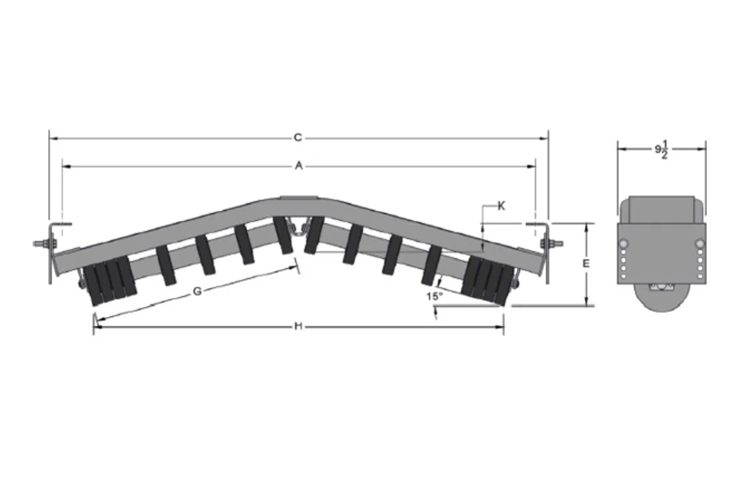
Spiral Return Idlers: Designed with a series of spiral-shaped discs that rotate independently, spiral return idlers are used to reduce the build-up of materials on the return side of the belt. They are particularly beneficial in environments where sticky or abrasive materials are conveyed.
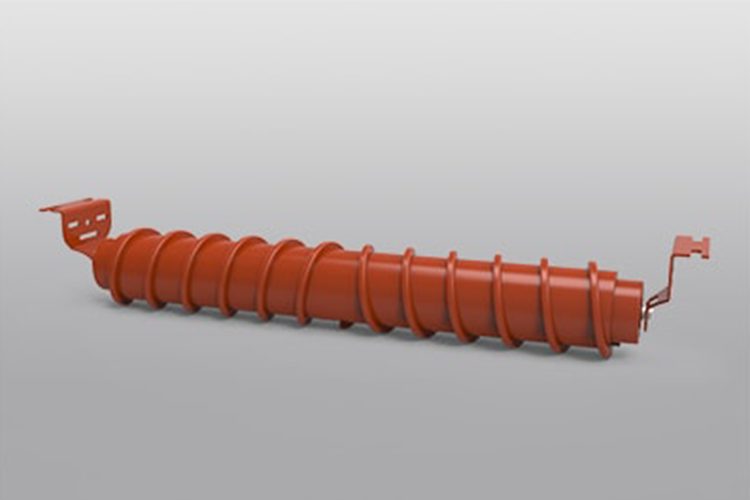
Rubber Disc Return Idlers: These idlers have rubber discs attached to the steel roll, providing additional protection against wear and tear. The rubber discs help in cleaning the belt and are ideal for use in situations where the conveyor belt may carry back materials.
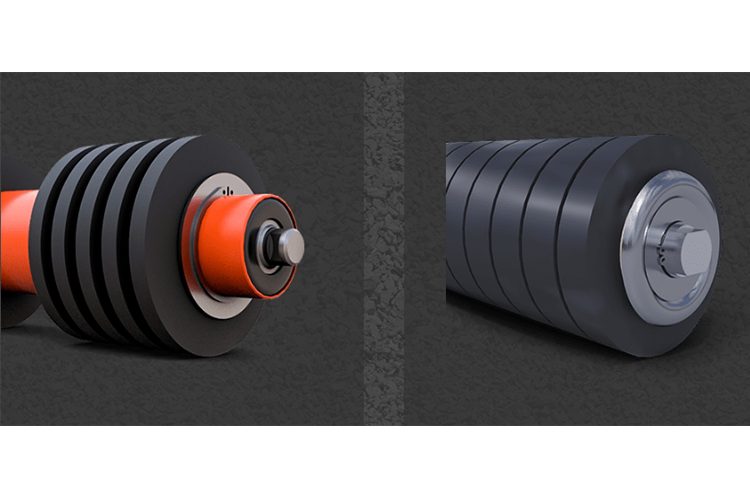
Impact Return Idlers: Similar to impact troughing idlers but designed for the return side of the belt, these idlers are equipped with cushioned rolls. They are used in the loading zones where the return belt receives an impact from falling materials.
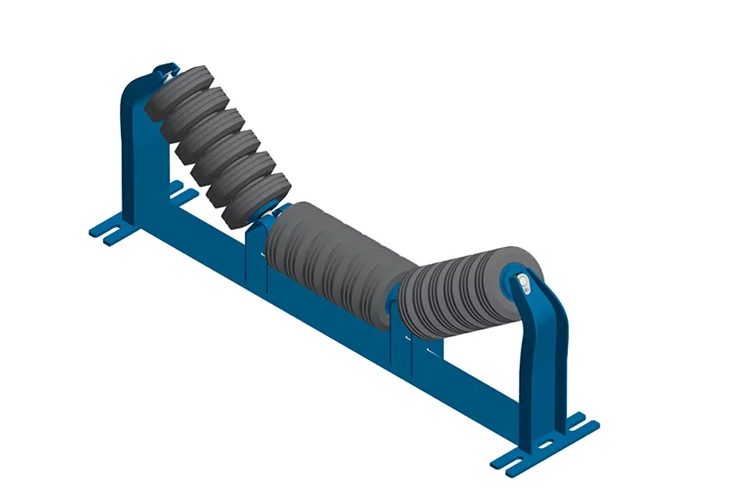
Each type of conveyor return idlers plays a vital role in the overall efficiency and longevity of a conveyor belt system. Selecting the right type depends on the specific requirements of the conveyor system, including the load, belt speed, and environmental conditions.Conveyor return idlers are essential for the efficient and smooth operation of conveyor systems. They support the return belt, help maintain the correct tension, and contribute to the overall longevity of the conveyor belt.
Type of Superior Idlers
Let’s delve into the types of superior idlers in the context of mechanical components, where idlers play a crucial role in the functioning of various machinery and conveyor systems. These components, often overlooked, are pivotal for tensioning, guiding, and supporting belts or chains in motion.
1. Heavy-Duty Idlers
Description
Heavy-duty idlers are designed to withstand high load capacities and are commonly used in industrial conveyors and heavy machinery. These idlers are made from durable materials capable of enduring extreme working conditions over extended periods.
Features
- High Durability: Engineered to withstand heavy loads, impacts, and prolonged wear and tear.
- Low Maintenance Requirements: Their materials and design are aimed at reducing the frequency and cost of maintenance.
- Versatile in Various Environments: Capable of operating effectively in dusty or moist conditions, ensuring reliability and longevity.
2. Precision Idlers
Description
Precision idlers are specifically designed for applications requiring high-precision positioning, such as in precision machinery or automated assembly lines. These idlers are manufactured with very tight tolerances to ensure minimal deviation in motion transfer.
Features
- High Precision: Minimal tolerances and superior manufacturing quality ensure precise motion transfer.
- Smooth Operation: Reduces vibration and noise, enhancing the overall efficiency of the machinery.
- Durability: Even under high-precision demands, these idlers maintain long-term durability and reliability.
3. Self-Aligning Idlers
Description
Self-aligning idlers automatically adjust their position to maintain the correct alignment of belts or chains. This is crucial for preventing belt misalignment and reducing unnecessary wear.
Features
- Automatic Adjustment: Capable of adjusting their position and angle based on operating conditions.
- Extended Belt Life: By maintaining correct alignment, these idlers reduce belt wear.
- Reduced Downtime: Minimizes maintenance and downtime associated with adjusting idlers.
4. Impact Idlers
Description
Impact idlers are specially designed to absorb the impact of materials falling onto conveyor belts. These idlers are typically installed at material drop points to protect the conveyor belt from damage.
Features
- Impact Absorption: Equipped with special materials or structures to absorb impact forces, protecting the conveyor belt.
- Extended Equipment Life: Reduces damage to the conveyor belt and the overall conveyor system.
- Suitable for Various Materials: Effective at absorbing impacts from coarse or heavy materials, ensuring the system’s longevity.
These superior idlers play a pivotal role in enhancing the efficiency, reliability, and longevity of conveyor systems and machinery. Their specialized designs and features address specific challenges, making them indispensable components in modern industrial operations.
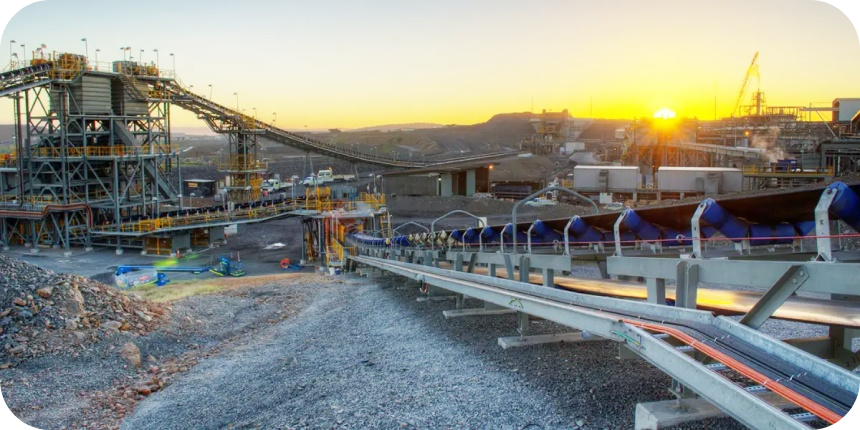
Conveyor Return Idler Materials and Design
The design and material composition of conveyor return idler are pivotal factors that determine their suitability for various industrial applications. Different materials offer distinct advantages and are selected based on the specific requirements of the conveyor system.
Materials Used in conveyor return idler
- Steel: Steel is the most commonly used material for conveyor return idler due to its strength and durability. It is ideal for heavy-duty applications where the idler is subjected to high loads and abrasive conditions. Steel idlers can withstand extreme environments and provide a long service life.
- Rubber: Rubber-coated idlers are used in applications where noise reduction and impact absorption are important. The rubber coating serves as a cushion, which helps in reducing the noise produced by the conveyor and also minimizes the impact on the idler caused by falling materials.
- Plastic: Plastic idlers, frequently crafted from robust polymers like high-density polyethylene (HDPE), possess the advantages of being lightweight and resistant to corrosion. They are well-suited for environments where steel idlers might be susceptible to corrosion, such as in chemical processing or outdoor applications exposed to the elements.
Design Variations
conveyor return idler come in various designs, each tailored to specific operational needs. For instance, some idlers have a flat design for general use, while others feature a trough shape for more effective support of the belt. The spacing and arrangement of the idlers can also vary, depending on the load and the type of material being transported.
Importance of Material Choice in Different Operating Environments
The selection of materials for conveyor return idler is crucial in different operating environments. In corrosive environments, materials like HDPE or coated steel are preferred to prevent rust and degradation. In applications involving high temperatures or abrasive materials, heat-treated or alloy steel idlers are more suitable due to their resistance to wear and deformation. The choice of material impacts not only the durability and maintenance requirements of the idlers but also the overall efficiency and safety of the conveyor system.
The materials and design of conveyor return idlers should be carefully considered to ensure optimal performance and longevity. The right combination of material and design can significantly enhance the efficiency of a conveyor system, reduce maintenance costs, and ensure smooth and safe operations.
Pricing and Purchasing Options of Conveyor Return Idler
When it comes to acquiring conveyor return idler, understanding the pricing dynamics and knowing where to purchase them is crucial for making informed decisions.
Conveyor Return Idler Price
The price of conveyor return idler can vary significantly based on several factors. Material quality is a primary determinant; for instance, idlers made from high-grade steel or specialized alloys tend to be more expensive than those made from standard materials. The design complexity and the specific features of the idler, such as self-aligning capabilities or specialized coatings for corrosion resistance, also influence the cost. Additionally, the brand reputation and the supplier’s location can affect pricing, with well-known brands and suppliers in high-cost regions typically charging more. For budgeting, it’s important to balance cost with quality and longevity. Investing in higher-quality idlers may result in lower long-term costs due to reduced maintenance and replacement needs.
Used Conveyor Return Idler
Purchasing used conveyor return idler can be a cost-effective option. The primary advantage is the lower upfront cost compared to buying new idlers. However, there are potential downsides to consider. Used idlers may have reduced lifespan and may not come with a warranty, leading to uncertainty about their future performance. There’s also the risk of inheriting any wear and tear or hidden faults from previous usage. It’s crucial to thoroughly inspect used idlers for any signs of damage or excessive wear before purchasing.
Conveyor Return Idler for Sale
Finding the right supplier for conveyor return idler involves considering several factors. It’s advisable to look for suppliers who have a good reputation in the market and can provide testimonials or references from previous customers. A diverse product range and the ability to offer custom solutions can also be beneficial, especially for specialized applications. Additionally, consider the supplier’s after-sales support and warranty terms. Reliable suppliers often provide comprehensive customer service, including installation guidance, maintenance tips, and a robust warranty. Trade shows, industry directories, and online marketplaces are good starting points for finding reputable suppliers.
When purchasing conveyor return idler, it’s important to consider the balance between cost and quality, the potential risks and benefits of buying used equipment, and the importance of choosing a reputable supplier who can meet specific needs and provide ongoing support.
Conveyor Return Idler:Installation and Maintenance
Proper installation and regular maintenance of conveyor return idler are crucial for the efficient operation and longevity of conveyor systems. Here’s a detailed guide:
Step-by-Step Guide on Installing conveyor return idler
1. Preparation: Before installation, ensure that the conveyor system is switched off and locked out to prevent accidental activation. Gather all necessary tools and the replacement idlers.
2. Removal of Old Idlers: If replacing old idlers, carefully remove them by loosening the brackets or mounts that hold them in place.
3. Positioning New Idlers: Place the new conveyor return idler in the correct position under the conveyor belt. Ensure they are aligned with the belt’s path and evenly spaced according to the manufacturer’s specifications.
4. Securing Idlers: Fasten the idlers to the conveyor frame using the provided mounts or brackets. Make sure they are securely tightened but allow for slight adjustments for alignment.
5. Alignment Check: Ensure that the idlers are perfectly aligned with the belt to prevent uneven wear or belt drifting. Use a straight edge or laser alignment tool for precision.
6. Final Inspection: After installation, inspect the conveyor return idler to ensure they rotate freely without wobble or resistance. Check for any obstructions or misalignments.
Maintenance Tips to Ensure Longevity and Optimal Performance
1. Regular Inspections: Conduct routine inspections of conveyor return idler for signs of wear, damage, or misalignment. Pay special attention to bearings, which are critical for smooth operation.
2. Lubrication: Regularly lubricate the idler bearings according to the manufacturer’s recommendations. Use the appropriate type of lubricant for your specific idlers.
3. Cleaning: Keep the idlers clean from debris and material build-up, which can cause imbalances and increased wear.
4. Adjustment and Alignment: Periodically check and adjust the alignment of the conveyor return idler to ensure they are parallel to the belt’s path. Misaligned idlers can lead to belt damage and decreased efficiency.
5. Replacement of Worn Idlers: Replace any idlers that show significant wear or damage. Delaying replacement can lead to more severe conveyor belt damage and increased downtime.
6. Record Keeping: Maintain records of maintenance activities, including inspections, lubrications, adjustments, and replacements. This helps in tracking the performance and identifying recurring issues.
By following these installation and maintenance guidelines, you can significantly enhance the performance and extend the lifespan of your conveyor return idler, ensuring that your conveyor system operates smoothly and efficiently.
Conveyor Belt Idler Rollers
Understanding the dynamics between conveyor belt idler rollers and conveyor return idler is essential for the optimal functioning of conveyor systems.
The Relationship Between Conveyor Belt Idler Rollers and Return Idlers
- Conveyor belt idler rollers and conveyor return idler work in tandem to support and guide the conveyor belt in its continuous loop. Idler rollers are situated on the upper side of the conveyor belt to bear the weight of the transported material. Conversely, conveyor return idlers are positioned beneath the conveyor belt, providing support for the belt’s return journey back to the initial point of the conveyor system.
- This interplay is essential to uphold the structural integrity of the conveyor belt and to guarantee seamless operation. Idler rollers play a pivotal role in evenly distributing the load, thus alleviating stress on the conveyor belt. In contrast, return idlers prevent sagging along the return path, which could otherwise result in belt misalignment and heightened wear and tear.
- Both types of idlers are vital in maintaining the belt’s alignment and tension, ensuring that the conveyor system operates efficiently and with minimal downtime.
How to Select the Right Idler Roller for Your Conveyor System
- Assess the Load and Belt Speed: The weight of the material being transported and the speed of the belt are critical factors in selecting the right idler roller. Heavier loads and higher belt speeds typically require more robust and durable idlers.
- Consider the Material Properties: The type of material being conveyed can influence the choice of idler roller. For abrasive materials, idlers with wear-resistant surfaces are preferable.
- Evaluate the Operating Environment: The environment in which the conveyor operates can impact the choice of idler roller. For instance, in corrosive or humid environments, idlers made from corrosion-resistant materials or with protective coatings are necessary.
- Determine the Idler Spacing: Proper idler spacing is essential for supporting the belt and the load effectively. This spacing depends on the belt width, load, and belt speed.
- Choose the Idler Type: Depending on the application, you might need standard flat idlers, troughing idlers for bulk material, or impact idlers for areas where the material is loaded onto the belt.
- Quality and Manufacturer Reputation: Opt for high-quality idlers from reputable manufacturers to ensure reliability and longevity. Quality idlers reduce the need for frequent replacements and maintenance.
The interplay between conveyor belt idler rollers and conveyor return idler is fundamental to the conveyor system’s efficiency. Selecting the right idler roller involves a thorough understanding of the system’s requirements, considering factors such as load, belt speed, material properties, operating environment, and idler spacing. Making an informed choice in selecting idler rollers can lead to improved conveyor performance, reduced maintenance costs, and increased operational lifespan.
Reliable and robust conveyor idlers to enhance your operational productivity. Act now!
Conveyor return idler:Catalogs and Resources
For professionals in the conveyor system industry, having access to detailed catalogs and resources is crucial for making informed decisions. Two notable catalogs in this field are the Superior Idler Catalog and the PPI Idlers Catalog, each offering a wealth of information on conveyor return idler.
Superior Idler Catalog:
- The Superior Idler Catalog is a comprehensive resource that provides detailed specifications and information on a wide range of conveyor return idler. This catalog is an essential tool for engineers and decision-makers in selecting the right idlers for their conveyor systems.
- It includes technical details such as idler dimensions, load ratings, bearing types, and material specifications. The catalog also provides insights into the design features that make Superior Idlers stand out, such as their durability, efficiency in operation, and ease of maintenance.
- Additionally, the Superior Idler Catalog often includes case studies and application examples, demonstrating how their idlers perform in various industrial settings. This practical information can be invaluable in understanding how different idler types can be optimized for specific conveyor system requirements.
PPI Idlers Catalog:
- Precision Pulley & Idler (PPI) offers a catalog that showcases their extensive range of conveyor idlers, including return idlers. The PPI Idlers Catalog is known for its detailed product descriptions and technical data, making it a valuable resource for industry professionals.
- The catalog covers various idler types, including standard return idlers, impact idlers, and specialty idlers designed for specific applications. Each product entry in the catalog includes information on sizes, capacities, and suitable applications, helping users to select the most appropriate idlers for their conveyor systems.
- PPI’s catalog also emphasizes the innovative aspects of their idlers, such as advanced sealing technology and materials engineered for longevity and reliability. This focus on innovation is particularly useful for those looking to enhance their conveyor systems with the latest in idler technology.
Both the Superior Idler Catalog and the PPI Idlers Catalog are invaluable resources for anyone involved in the design, operation, or maintenance of conveyor systems. These catalogs not only provide detailed product specifications but also offer insights into the latest advancements in conveyor return idler technology. Accessing these resources can significantly aid in the selection of the right idlers, ensuring optimal conveyor system performance.
Case Studies and Applications
Exploring real-world applications and case studies of conveyor return idler usage provides valuable insights into their versatility and effectiveness across various industries.
Real-World Examples of Conveyor Return Idler Applications
- Mining Industry: In one notable case, a mining company faced frequent conveyor belt misalignments in its coal transport system. The introduction of specialized self-aligning conveyor return idler significantly reduced downtime caused by misalignments. These idlers automatically adjusted the belt’s position, ensuring continuous and efficient coal transportation.
- Agriculture Sector: A large agricultural processing plant utilized conveyor return idler to streamline the movement of grains. The idlers supported the heavy load of grains on the return path, reducing belt sag and ensuring a smooth flow of materials, which was crucial during peak harvest seasons.
- Manufacturing Facilities: In a car manufacturing plant, conveyor return idler were integral in the assembly line. They provided stable support for the conveyor belts that transported parts and assemblies, ensuring precision and efficiency in the manufacturing process.
How Different Industries Utilize These Components
- Food and Beverage Industry: conveyor return idler in the food and beverage industry are often made from materials like stainless steel or food-grade plastics to meet hygiene standards. They are used in processing and packaging lines, where cleanliness and minimal downtime are crucial.
- Recycling and Waste Management: In recycling plants, conveyor return idler are subjected to harsh conditions, including exposure to various materials and debris. Here, idlers with robust designs and protective coatings are used to withstand these challenging environments.
- Logistics and Distribution: Distribution centers use conveyor return idler to maintain efficient and reliable sorting and transportation of goods. The idlers support high-speed conveyor systems that are essential for timely delivery and handling of products.
These case studies and industry applications demonstrate the critical role of conveyor return idler in enhancing operational efficiency, reducing maintenance needs, and supporting various material handling requirements. Their adaptability across different sectors underscores their importance in modern industrial and commercial operations.
If you aim to improve the efficiency and lifespan of your conveyor systems, exploring the realm of conveyor return idlers is a positive move. Whether you’re in the early stages of system design, considering upgrades for your current setup, or simply need more comprehensive information, we are here to provide assistance. Our extensive range of conveyor return idler is designed to meet diverse industrial needs, ensuring your conveyor system operates at its peak performance.
We welcome you to get in touch with us to gain a deeper understanding of how our conveyor return idler can specifically benefit your application. Our team of experts is prepared to offer you personalized advice, provide comprehensive product specifications, and share insights into the latest advancements in conveyor technology. Furthermore, we invite you to explore our extensive catalogs, which provide a detailed overview of our wide-ranging product offerings. These catalogs include information about specifications, features, and practical examples of how our conveyor return idlers can be effectively utilized.
Don’t miss the opportunity to optimize your conveyor system with high-quality conveyor return idler. Contact us today to learn more, request a catalog, or discuss your specific conveyor needs. We are committed to providing you with solutions that enhance efficiency, reduce maintenance, and contribute to the success of your operations.
FAQs about Conveyor Return Idler
An idler in a conveyor system works by providing support to the conveyor belt. It helps to maintain the belt’s shape and alignment, ensuring smooth and efficient movement of materials along the belt. Idlers are strategically placed along the conveyor path to distribute the weight of the load evenly and reduce wear on the belt.
In a conveyor system, the front idler is usually situated at the endpoint of the conveyor, precisely where the belt changes direction. Its primary role is to guide and provide support to the front part of the conveyor belt, ensuring it stays correctly aligned and maintains the necessary tension. This alignment and tension are essential factors for the efficient transportation of materials.
A troughing idler is a specific type of conveyor idler that incorporates a series of rollers arranged in a manner that creates a trough shape. This configuration is particularly useful for keeping bulk materials securely on the conveyor belt, particularly in situations where the conveyor must transport materials over extended distances or at high speeds.Troughing idlers are crucial for preventing spillage and ensuring the stable and efficient transport of materials.
An idler pulley within a belt conveyor has the crucial role of being a non-driven pulley that guides and supports the conveyor belt. It is typically employed to redirect the belt’s path or apply tension to it. Idler pulleys are essential components for ensuring the conveyor belt maintains the proper tension, preventing any slipping, and ensuring the conveyor system operates smoothly.
The primary distinction between an idler pulley and a drive pulley in belt conveyors is that the idler pulley is not linked to the conveyor’s motor and does not provide direct power to move the belt. Instead, its role is to guide, tension, and support the belt. On the other hand, a drive pulley is connected to the motor and is responsible for propelling the conveyor belt by transmitting power from the motor to the belt.
Last Updated on June 7, 2024 by Jordan Smith
Jordan Smith, a seasoned professional with over 20 years of experience in the conveyor system industry. Jordan’s expertise lies in providing comprehensive solutions for conveyor rollers, belts, and accessories, catering to a wide range of industrial needs. From initial design and configuration to installation and meticulous troubleshooting, Jordan is adept at handling all aspects of conveyor system management. Whether you’re looking to upgrade your production line with efficient conveyor belts, require custom conveyor rollers for specific operations, or need expert advice on selecting the right conveyor accessories for your facility, Jordan is your reliable consultant. For any inquiries or assistance with conveyor system optimization, Jordan is available to share his wealth of knowledge and experience. Feel free to reach out at any time for professional guidance on all matters related to conveyor rollers, belts, and accessories.



